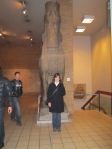 My latest adventure took me to The British Museum, a deceptively simple-named but rich-in-history museum located in London. Here, most of the museum exhibits are free, with a charge for any special exhibits, but after an afternoon of being there, I realized quickly that among the free things there are to see, there is more content than could possibly seen in a day. I travelled with some friends from church, as one of the girls had to go up to train as a volunteer for the paraplegic olympics, and a few others of us just tagged along for the ride to poke around London for the day.
My latest adventure took me to The British Museum, a deceptively simple-named but rich-in-history museum located in London. Here, most of the museum exhibits are free, with a charge for any special exhibits, but after an afternoon of being there, I realized quickly that among the free things there are to see, there is more content than could possibly seen in a day. I travelled with some friends from church, as one of the girls had to go up to train as a volunteer for the paraplegic olympics, and a few others of us just tagged along for the ride to poke around London for the day.
We started our trek into the past with a visit to the Greeks. Galleries were filled with intricately painted pottery and life-sized statues of gods and political figures, and in one room, there was even the front of a giant architectural structure that had been moved inside for viewing. How they got it there, I have no idea. Something particular I found was the head of a copper sculpture of Apollo. While the piece itself was impressive (the locks of hair were each crafted individually and then attached, which must have taken quite some time), what I found the most amusing was the plaque under it, which read that one of the legs to this sculpture is now on display in the Louvre. It seemed strange that they would separate this piece, and I thought that it was even funnier that in the Louvre somewhere, there’s a pedestal with a single leg on it. The head was beautiful, but I have a difficult time imagining that a leg would be quite as interesting to look at.
From the Greeks we moved on to another great civilization: the Egyptians. This exhibit was significantly more colorful and ornate  than that of the Greeks. Carved stone and black vases gave way to beaded jewelry and 22K gold coffins, or sarcophagi (as we learned the correct term for). I am convinced that the Egyptians must have been the inspiration behind the Russian nesting dolls, as some of the mummies had multiple nesting cases which would then be placed in a large stone box as their final holding place underground. In addition, I was able to see some old Egyptian flutes and a stringed instrument, so that’s always fun for a music major. I will admit, it felt really weird and slightly unsettling to be in a room full of mummies. To look at the wrapped figures, or sometimes the collections of human bones, and think that these people have been deceased for thousands of years was enough to give me the chills!
than that of the Greeks. Carved stone and black vases gave way to beaded jewelry and 22K gold coffins, or sarcophagi (as we learned the correct term for). I am convinced that the Egyptians must have been the inspiration behind the Russian nesting dolls, as some of the mummies had multiple nesting cases which would then be placed in a large stone box as their final holding place underground. In addition, I was able to see some old Egyptian flutes and a stringed instrument, so that’s always fun for a music major. I will admit, it felt really weird and slightly unsettling to be in a room full of mummies. To look at the wrapped figures, or sometimes the collections of human bones, and think that these people have been deceased for thousands of years was enough to give me the chills!
In addition, here I was lucky enough to see the actual Rosetta Stone, which is a stone tablet which was a key in decoding Egyptian hieroglyphics (which lead to being able to learn more about the Egyptian culture). I remember reading about it in history books as far back as elementary school, and so to actually see it in person was quite exciting. However, it was also a little sobering. As I stood there, looking at it, and thinking of all the cool things I had seen, and would see, and then thinking of all the opportunities that are coming my way, I felt deeply grateful for the chance that I have to study here and knew I was truly very lucky.
 After a somewhat heavy forty minutes, we headed on to the most glamorous exhibit of the day, which contained historical artifacts from England’s history of conquest. Tiaras, jewels, dishes, and containers of all shapes and sizes glittered from behind the glass cases. One plate I found particularly intriguing, as it had a three-dimensional art design which consisted of a pond, fish, and a large snake going down the center. It didn’t seem very practical for serving food (and it looked like a pain to wash!), but the more I thought about it, very few of these exquisite golden or otherwise delicate dishes seemed very practical for serving food. Still, the snake platter was especially strange, and I couldn’t help but wonder what makes potters and artists decide what makes something a good idea for a food dish.
After a somewhat heavy forty minutes, we headed on to the most glamorous exhibit of the day, which contained historical artifacts from England’s history of conquest. Tiaras, jewels, dishes, and containers of all shapes and sizes glittered from behind the glass cases. One plate I found particularly intriguing, as it had a three-dimensional art design which consisted of a pond, fish, and a large snake going down the center. It didn’t seem very practical for serving food (and it looked like a pain to wash!), but the more I thought about it, very few of these exquisite golden or otherwise delicate dishes seemed very practical for serving food. Still, the snake platter was especially strange, and I couldn’t help but wonder what makes potters and artists decide what makes something a good idea for a food dish.
 My favorite things were some of the last things we saw. First, they had a display of the gold medals for the 2012 Olympics. It was neat to see them in person, knowing that this is the closest I’ll ever get to one, and thinking about what they will soon mean for someone come July. I can hardly imagine what it would feel like to win one. And my absolute favorite exhibit was the one that came last, and it was all about clocks and automatons. Perhaps it’s because I watched Hugo, or perhaps it was just the fact that I loved the intricacy of everything. But there were two rooms full of beautiful machines which came in all forms, from typical grandfather clocks to ships to (my favorite) a girl milking a cow.
My favorite things were some of the last things we saw. First, they had a display of the gold medals for the 2012 Olympics. It was neat to see them in person, knowing that this is the closest I’ll ever get to one, and thinking about what they will soon mean for someone come July. I can hardly imagine what it would feel like to win one. And my absolute favorite exhibit was the one that came last, and it was all about clocks and automatons. Perhaps it’s because I watched Hugo, or perhaps it was just the fact that I loved the intricacy of everything. But there were two rooms full of beautiful machines which came in all forms, from typical grandfather clocks to ships to (my favorite) a girl milking a cow.
There was so much to see, and we didn’t even begin to scratch the surface, but I’ll go back soon. Perhaps I’ll go after my first horn lesson on Saturday (which I am VERY excited for). And now, to practice.
Amanda










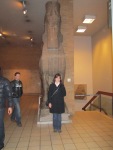

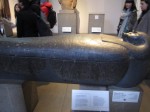






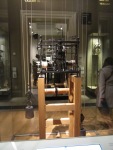

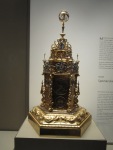


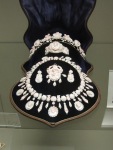


Thanks for logging (blogging) all your adventures. Love to read them.
Dad
You know I am with your about the room full of mummy’s :) Art and History majors would probably love all the museums you are going to!